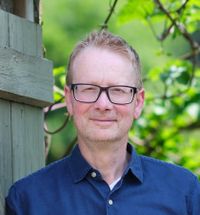Eat up your daylilies: The underappreciated east Asian flower that's a marvel in the kitchen
Mark Diacono was at first suspicious of cutting the stem of a gorgeous red daylily, until he realised how delicious they are.


Of all the edible flowers rightly championed, I think daylilies receive too little appreciation. In both beauty and culinary pleasure, they really are hard to equal. Daylilies are not true lilies, but belong to the genus Hemerocallis — from the Greek hemera, meaning day, and kallos, meaning beauty — which hints at the flowers’ fleeting nature. Typically opening at first light, each flower cheers the garden until the evening, when it fades rapidly. At first, I had trouble with the idea of robbing the garden of something so beautiful, but picking them late in the day before the decline sets in means I get to enjoy them twice: outside and in the kitchen. Happily, flowers are typically produced over a number of weeks, so you can expect more beauty to replace that which has gone.
When I say daylilies are underappreciated, I mean here in the UK. In their eastern Asia home, the daylily’s culinary and medical properties have long been enjoyed, with dried and fresh flowers used in everything from hot and sour soups to pork dishes. I love the flowers raw or cooked: as well as casting a just-picked few into a leafy salad, try them deep-fried in tempura batter with a sweet/sour chilli dipping sauce.

Workers drying daylily at a food processing enterprise in Hengyang, in the Hunan Province of China.
It’s not only their flowers that are worth eating. All parts are edible, offering a range of harvests throughout the year, which made them popular with early American settlers. In spring, the early outer leaves can be harvested in moderation. They have a mild onion flavour and, although good as they are, I like them best when gently fried in butter. As well as the flowers themselves, early summer brings flower buds that are really good to eat, with a flavour that reminds of French green beans; they are especially good lightly stir-fried or steamed and bring a nutty punctuation to salads. From late autumn into winter, when the tubers have developed well through the summer, you can dig up the plant (perhaps at the same time as you divide, see below) and harvest a few rhizomes, leaving most to grow on. These rhizomes taste like salsify — somewhere between asparagus and globe artichokes — and are best boiled or steamed, before being lightly cooked in butter with a little cream.
There is no shortage of daylily varieties to choose from, but take your time. As well as colour and flavour variations (yellow flowers tend to be sweetest, with red more full of flavour), some have a peak of productivity that’s earlier than others, so with thought you can have a long season of beauty and harvesting. I’ve grown ‘Stella de Oro’ for years: at 16in or so in height, it is smaller than some, which works perfectly in the right place and in containers, and its prolific yellow flowers are delicious. ‘Red Rum’ and ‘Sammy Russell’ are perhaps the tastiest red-flowering varieties. Both a little taller than ‘Stella de Oro’, they flower over a long period and are hardier than most, which makes either a fine choice for the coldest locations. If you want something taller, growing to 3ft or so in height, consider Hemerocallis fulva, the type most widely cultivated in China and Japan.
Once established, daylilies are steadily, generously, productive and even a few plants will provide all you need to eat, but the more you grow, the more variety and the longer season you can invite into your garden and kitchen. They are a dream to grow, being hardy, perennial, requiring little care and tolerant of all but extreme conditions. Plant in full sun, in a little well-drained soil, and they should flourish. Although they can be grown from seed, starting with young plants ensures the characteristics of a known variety.
A post shared by Valerie Zemba (@veryveganval)
A photo posted by on
As well as slowly clumping up into something a little more substantial, daylilies are easy to multiply by division. In late winter or early spring, lift an established plant and slice the base into quarters with a sharp spade or bread knife and plant each immediately or break off new shoots with a little of their roots and pot up until growing well.
Pests and diseases are few. Slugs and snails can be a nuisance with the freshest growth, but daylilies are vigorous enough to grow through their attentions, although be mindful of young plants perhaps needing some help. If you see any overly swollen buds that refuse to open, snap them off and incinerate them, as it may be that the grub of the hemerocallis gall midge has taken up residence.
Exquisite houses, the beauty of Nature, and how to get the most from your life, straight to your inbox.
Mark Diacono grows edibles, both usual and unusual, at Otter Farm in Devon. His book 'Abundance: eating and living with the seasons' (Quadrille) is out at the end of this month
This feature originally appeared in the August 6, 2025, issue of Country Life. Click here for more information on how to subscribe
Mark is lucky enough to spend most of his time eating, growing, writing and talking about food. He has written fourteen award-winning books, including A Year at Otter Farm and A Taste of the Unexpected (both won Food Book of the Year, and Garden Book of the Year). Known for growing everything from Szechuan pepper to pecans to Asian pears, Mark's refreshing approach to growing and eating has done much to inspire a new generation to grow some of what they eat. He was involved in the early days of River Cottage, appearing in the TV series, and writing four River Cottage books. Mark writes to a global audience on his best-selling Substack: Mark Diacono’s Abundance.
